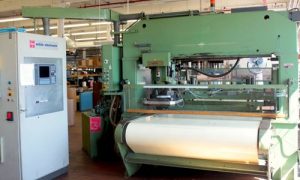 In manufacturing, die cutting services are used to produce a large volume of parts of the same size and shape. A die cutting process employs specialized machines that cut parts from an assortment of web material—wood, plastic, metal, rubber, fabric, textile, foam, corrugation, vinyl, silicone, paper, foil, and much more. The die cut pieces are referred to as “blanks,” as they are either pieces that need finishing before being sold or parts that will be used in the assembly of another manufactured product.
In manufacturing, die cutting services are used to produce a large volume of parts of the same size and shape. A die cutting process employs specialized machines that cut parts from an assortment of web material—wood, plastic, metal, rubber, fabric, textile, foam, corrugation, vinyl, silicone, paper, foil, and much more. The die cut pieces are referred to as “blanks,” as they are either pieces that need finishing before being sold or parts that will be used in the assembly of another manufactured product.
Die cutting services are used in a wide array of industries—aerospace, electronics, medical, HVAC, high tech, renewable energy, textiles, textile, and industrial equipment manufacturing. Die cutting processes are then used to manufacture parts for household items, electric gadgets, office supplies, complex engineering devices, paper clips, IT hardware and countless other items. The quality of die cuts is integral to ensure that all product parts have the same characteristics.
Dies are specialized devices, i.e., tools used for cutting out, forming, or stamping material. In many ways, think of it as an industrial-sized cookie cutter. Die cuts are steel casts designed to cut specific patterns into thin pieces of material to produce a uniform shape. Die cutting requires specially shaped steel blades that are mounted and constructed to the desired form for the cutting and shaping of the material. The blades are then pressed onto the material to cut out the required shapes.
Dies can cut single pieces from a web of material or some dies can cut through several layers of material simultaneously to generate a stack of blanks. For more efficiency, multiple dies can be fitted together to cut high volume runs with one pressing.
How Does the Die Cutting Process Work?
The die cutting processes performed depend on specific methods to produce the desired cuts, designs, and parts. There are several types of common die cutting methods used, including flatbed die, laser, rotary die cutting, digital, punch press, and platen press. As the different names suggest, the particularities of the process are related to the name. For example, laser cutting dies utilizes a high-speed laser cutting machine. Rotary die cutting uses a cylindrical die and a rotary press. Essentially, the application requirements for the finished piece or blank determines the type of die cutting method most suitable for the part.
Cutting Methods and Applications
Die cutting consists of several different cutting methods for different applications. One form of die cutting, known as kiss cutting, is a popular print finishing technique. It’s used for a variety of applications to produce unique and meticulous adhesive designs. Kiss cutting is utilized for various types of adhesive labels, stickers, coupons, and like applications with two thin layers of material. The die cutting performs a very light impression through the top layer–cutting just deep enough to penetrate the top surface leaving the substrate intact. Thus, the die cutting “kisses” the backing material without cutting it, giving the steel rule die or knife that performs the process its name. Kiss cutting is done on a number of familiar adhesive-backed materials—vinyl, paper, foils and so on.
Not all die cutting is used to cut out shapes from the material. Sometimes it’s done to reshape material. That process is referred to as creasing. Certain material finishing requirements use creasing to enable bending or folding of the material. It can be done to any material that needs to be folded by hand like a box or carton or perforated for a page inserted within a leaflet or magazine to be easily and evenly removed. Creasing uses blunt blades that are fitted into the die to produce an indentation in the material, instead of cutting through it. That way it creates increased flexibility at two stress points in the material to reduce the stress on the material when folded.
Expert Die Cutting Services
Custom die cutting is a technique performed to produce prototypes for new products. H. Loeb Corporation can design and manufacture custom dies to meet the exact specifications needed for the application. Consideration is also given to the material best suited to the end product—one that will produce the best results and greatest yield at the most competitive price. Once the prototype is approved, orders can be fulfilled typically within ten working days. Die cutting is a highly skilled trade that requires a great deal of attention to detail and expert knowledge. H. Loeb Corporation has gained expertise in material sciences and applications through the years to better assist our customers in all the industries that we serve. For more information on how we can meet your needs, contact us today.
